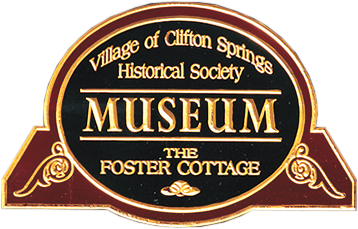Bath Treatments at "The Clifton Springs Sanitarium" ~ Part 3
By Jim Conners, Village Historian
Clifton Springs was originally known as Sulphur Springs back in the early 1800's. There are no records as to when or why the name was changed,
but it was the use of sulphur water from the natural sulphur springs that became the foundation of Clifton Springs as we know it today. The Clifton Springs
Water Cure was founded in 1850 because of the sulphur water. The sulphur water was in such demand that in one of the deeds pertaining to the land belonging
to the United Methodist it is stated that, "except for enough water to keep the horse troughs filled, the water rights belong to the Sanitarium".
People would drink this special water as can be seen in pictures of the Peirce Pavilion. And there are stories of people getting off the trains as they
stopped in Clifton Springs and filling containers at a fountain next to the railroad station.
I know most of you are aware that the Sanitarium used the sulphur water for medical treatment baths. Several of the baths that were offered used the sulphur
water as well as regular water. Taking excerpts from booklets for treatments, I would like to go into some of the details of a few of the different types of baths.
- Needle bath: Patient is to be undressed and escorted into the spraying stall. Water is to be turned on to a temperature of 98 to 102 degrees, for 4 to 7 minutes then reduced rapidly to 70 degrees or as cold as cane be borne (tolerated). Using a hose a few feet away the patient is sprayed with a needle like spray. Then the patent is covered by a sheet, dried quickly, and rubbed until reaction or warmth occurs.
- Electro-Thermal: Water to be at a temperature of 96 to 100 degrees and covering the body. Patient is to be put into the tub, and the current to be turned to the head and foot plates. And then turned up until the patient is sensible of a slight muscular contraction. Then the current is to be turned into the side plates. Patient is to be taken from the water and placed under a rose spray beginning at 96 or 98 degrees and reducing the temperature until the water is as cold as the patient can bear.
- Electro-Chemical: The material to be used is a teacup and a half of salt, a teacup of phosphate of iron and about 2 ounces of battery fluid. Patients are to be undressed and iodine to be applied to the portion of the body indicated on their prescription. They are then placed into the tub for 6 to 15 minutes.
- Salt Rub: Patient to be undressed and escorted to the salt run stall, where the flow of hot water is made to shower over the body. Stepping out of the flow room the attendant rubs the patient thoroughly with his hands in which he holds semi-dissolved salt, the distribution of the rubbing to be sufficient vigor to bring a redness to the skin.
- Russian Bath: The room should always be well-aired and warmed to at least 100 degrees. The patient should drink one glass or more of water before entering the room and one glass while in the room. After entering the room an ice-cap is place on the head and feet of the patient and put into the hot cabinet.
- Sulphur Bath: The temperature of the sulphur water starts at 100 degrees and is increased to 105 degrees for 20 minutes. The attendant carefully rubs the patients joints under the water.
These are a few of the baths of which there were many others. There were three locations for the baths. The ladies baths were reached by elevator #2 to the bath landing and the men's were on the first floor. There were additional baths located across the street in the basement of the Foster Building. (Tiles on the wall can still be seen where the baths were in the basement on the East end). The sulphur brook actually runs under the Foster Building.


